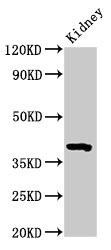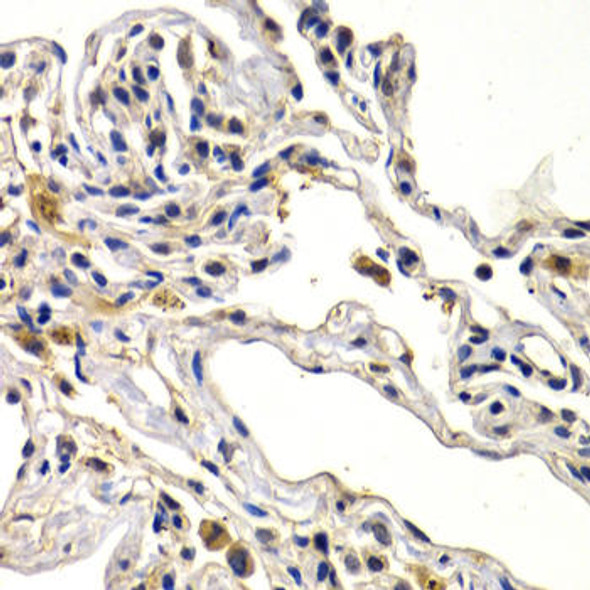Wnt3 Antibody (PACO31088)
- SKU:
- PACO31088
- Product type:
- Antibody
- Reactivity:
- Mouse
- Host Species:
- Rabbit
- Isotype:
- IgG
- Application:
- ELISA
- Application:
- WB
- Antibody type:
- Polyclonal
- Conjugation:
- Unconjugated
Frequently bought together:
Description
| Antibody Name: | Wnt3 Antibody (PACO31088) |
| Antibody SKU: | PACO31088 |
| Size: | 50ug |
| Host Species: | Rabbit |
| Tested Applications: | ELISA, WB |
| Recommended Dilutions: | ELISA:1:2000-1:10000, WB:1:500-1:2000 |
| Species Reactivity: | Mouse |
| Immunogen: | Recombinant Mouse Proto-oncogene Wnt-3 protein (22-355AA) |
| Form: | Liquid |
| Storage Buffer: | Preservative: 0.03% Proclin 300 Constituents: 50% Glycerol, 0.01M PBS, PH 7.4 |
| Purification Method: | >95%, Protein G purified |
| Clonality: | Polyclonal |
| Isotype: | IgG |
| Conjugate: | Non-conjugated |
 | Western Blot Positive WB detected in: Mouse kidney tissue All lanes: Wnt3 antibody at 3.2µg/ml Secondary Goat polyclonal to rabbit IgG at 1/50000 dilution Predicted band size: 40 kDa Observed band size: 40 kDa . |
| Background: | Ligand for members of the frizzled family of seven transmembrane receptors. Wnt-3 and Wnt-3a play distinct roles in cell-cell signaling during morphogenesis of the developing neural tube. |
| Synonyms: | Proto-oncogene Wnt-3 (Proto-oncogene Int-4), Wnt3, Int-4 Wnt-3 |
| UniProt Protein Function: | WNT3: Ligand for members of the frizzled family of seven transmembrane receptors. Wnt-3 and Wnt-3a play distinct roles in cell-cell signaling during morphogenesis of the developing neural tube. Defects in WNT3 are the cause of autosomal recessive tetra-amelia (ARTTRA). Tetra-amelia is a rare human genetic disorder characterized by complete absence of all four limbs and other anomalies such as craniofacial, nervous system, pulmonary, skeletal and urogenital defects. Belongs to the Wnt family.Protein type: Secreted, signal peptide; Oncoprotein; SecretedCellular Component: proteinaceous extracellular matrix; extracellular space; cytoplasm; extracellular regionMolecular Function: protein domain specific binding; protein binding; frizzled binding; receptor bindingBiological Process: limb development; embryonic forelimb morphogenesis; axon guidance; Wnt receptor signaling pathway; multicellular organismal development; cell morphogenesis; dorsal/ventral axis specification; positive regulation of collateral sprouting in the absence of injury; Wnt receptor signaling pathway through beta-catenin; signal transduction; negative regulation of axon extension involved in axon guidance; embryonic hindlimb morphogenesis; Spemann organizer formation at the anterior end of the primitive streak; anterior/posterior pattern formation; limb bud formation; organ morphogenesis; mesoderm formation; cell-cell signaling; gamete generation; anatomical structure formation; anterior/posterior axis specification |
| UniProt Protein Details: | |
| NCBI Summary: | |
| UniProt Code: | P17553 |
| NCBI GenInfo Identifier: | 6678593 |
| NCBI Gene ID: | 22415 |
| NCBI Accession: | NP_033547.1 |
| UniProt Secondary Accession: | P17553 |
| UniProt Related Accession: | P17553 |
| Molecular Weight: | 39,659 Da |
| NCBI Full Name: | proto-oncogene Wnt-3 |
| NCBI Synonym Full Names: | wingless-type MMTV integration site family, member 3 |
| NCBI Official Symbol: | Wnt3 |
| NCBI Official Synonym Symbols: | Int-4; Wnt-3 |
| NCBI Protein Information: | proto-oncogene Wnt-3; proto-oncogene Int-4; proto-oncogene protein Wnt-3; wingless-related MMTV integration site 3 |
| UniProt Protein Name: | Proto-oncogene Wnt-3 |
| UniProt Synonym Protein Names: | Proto-oncogene Int-4 |
| Protein Family: | Proto-oncogene |
| UniProt Gene Name: | Wnt3 |
| UniProt Entry Name: | WNT3_MOUSE |






